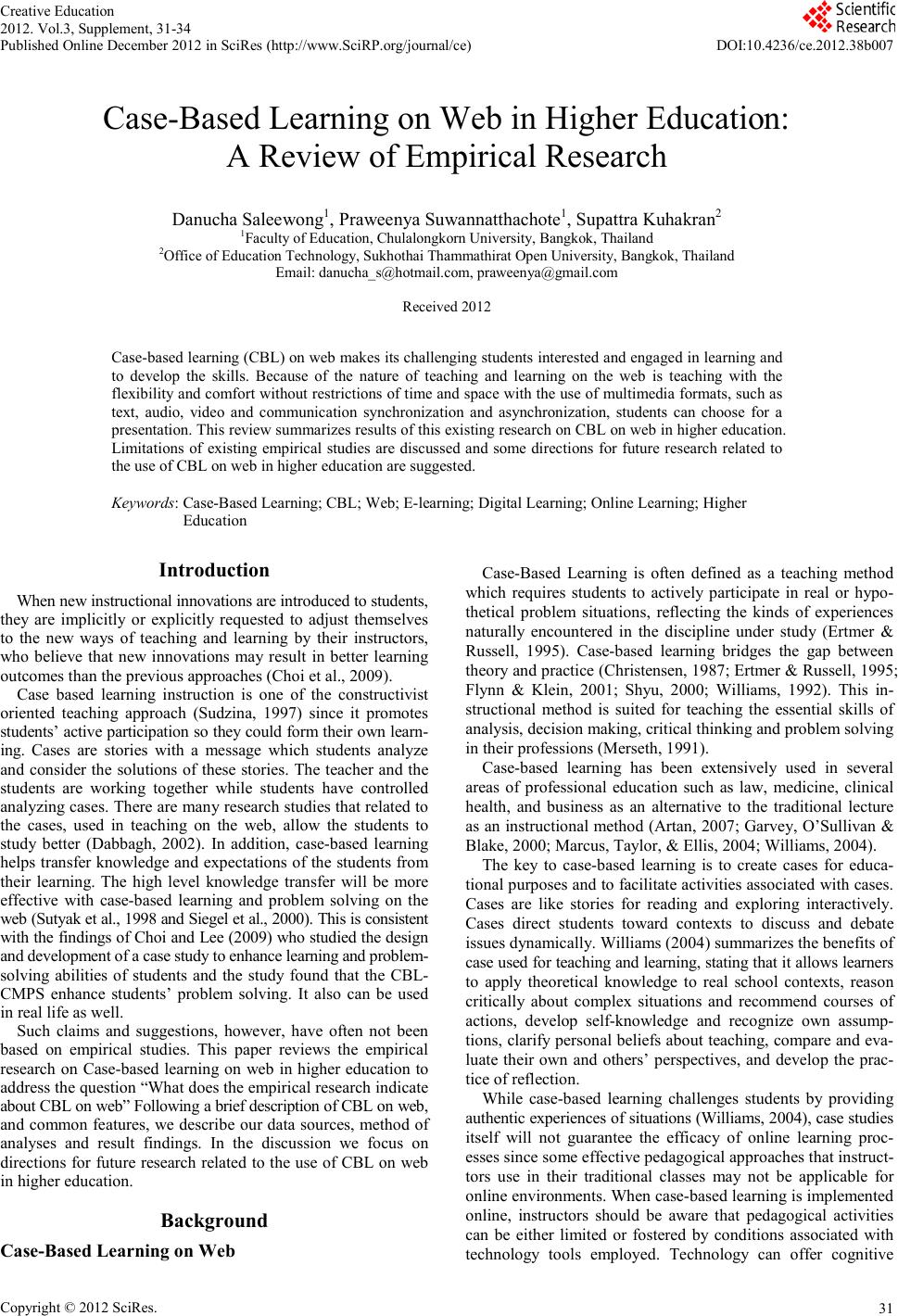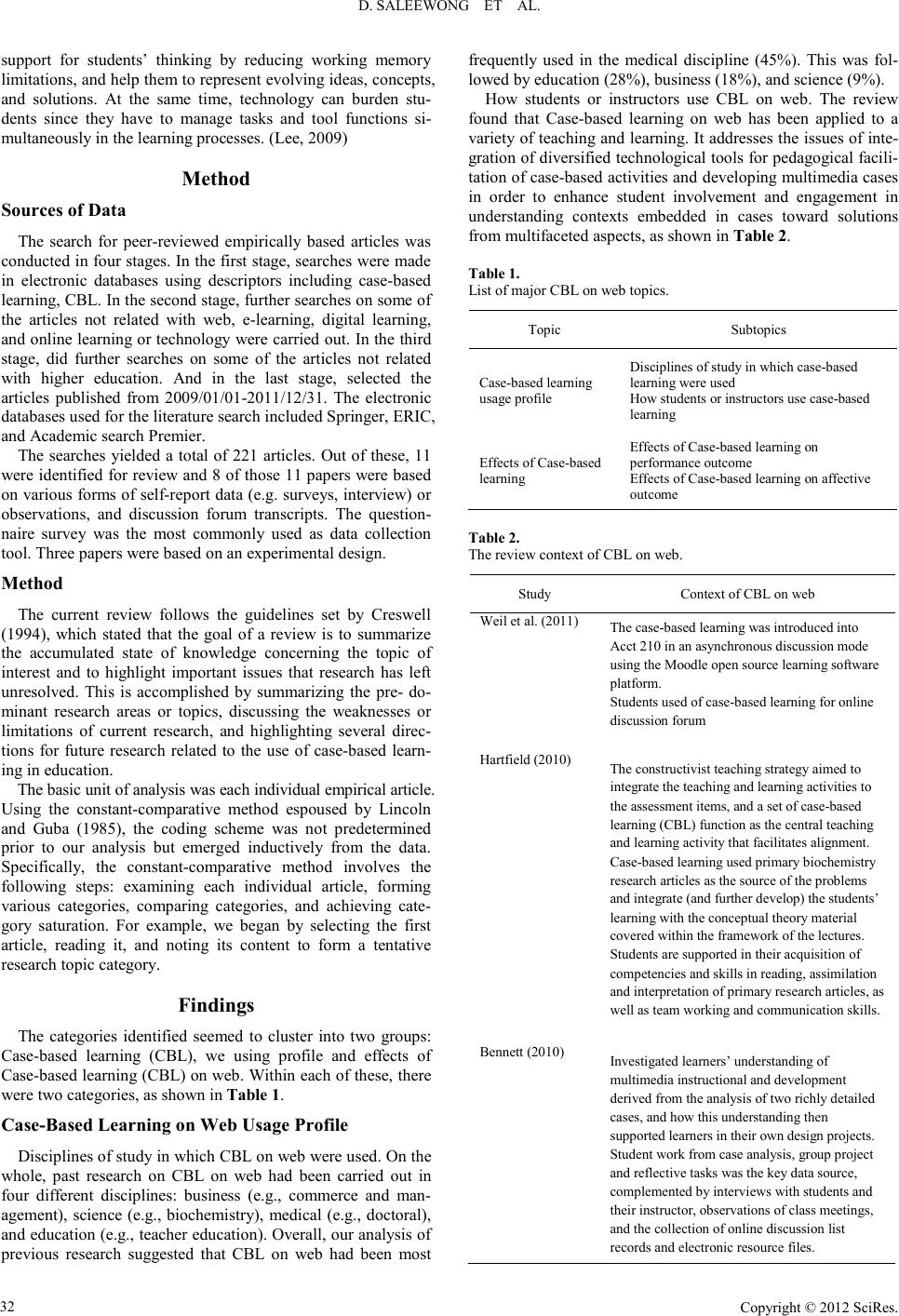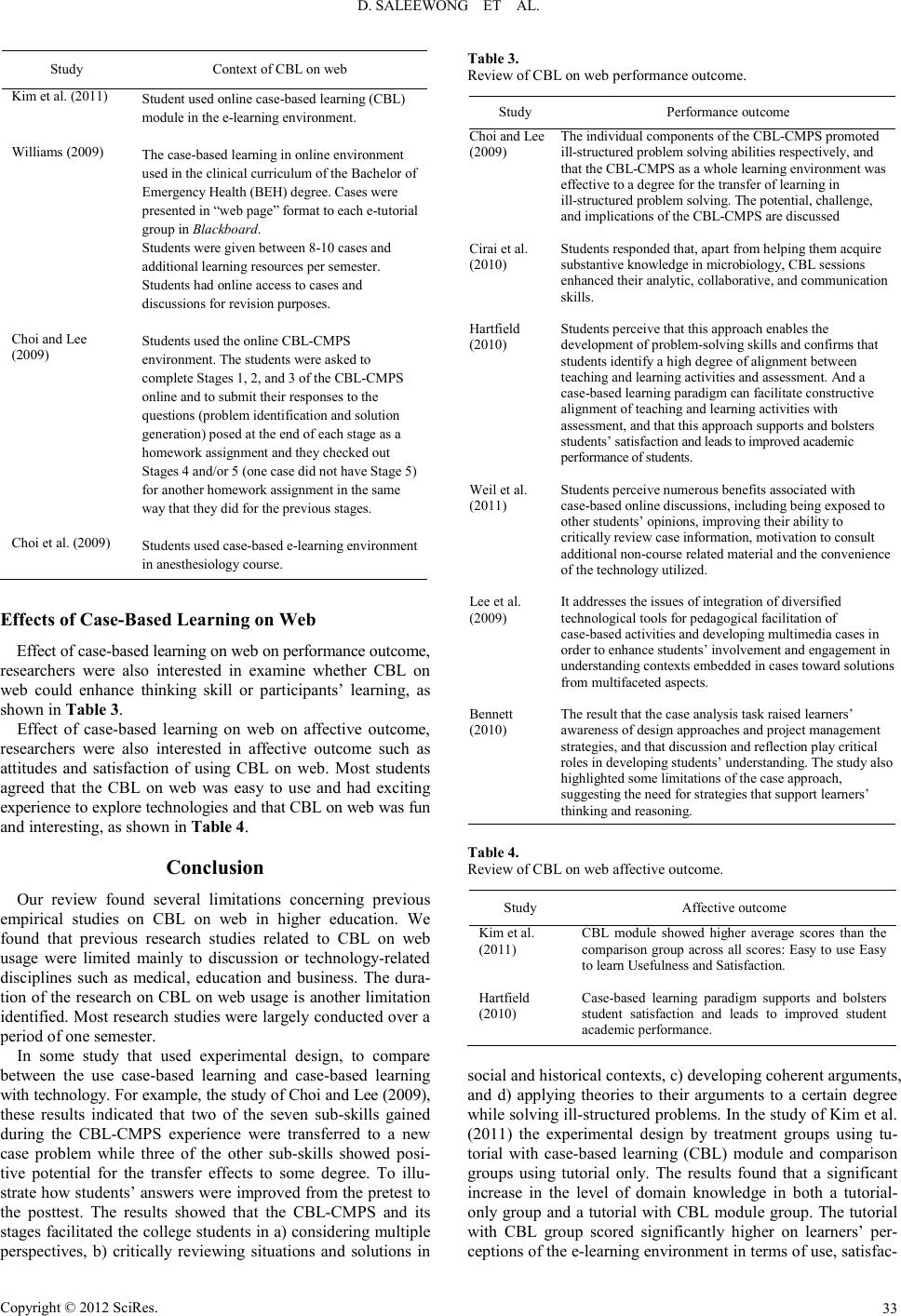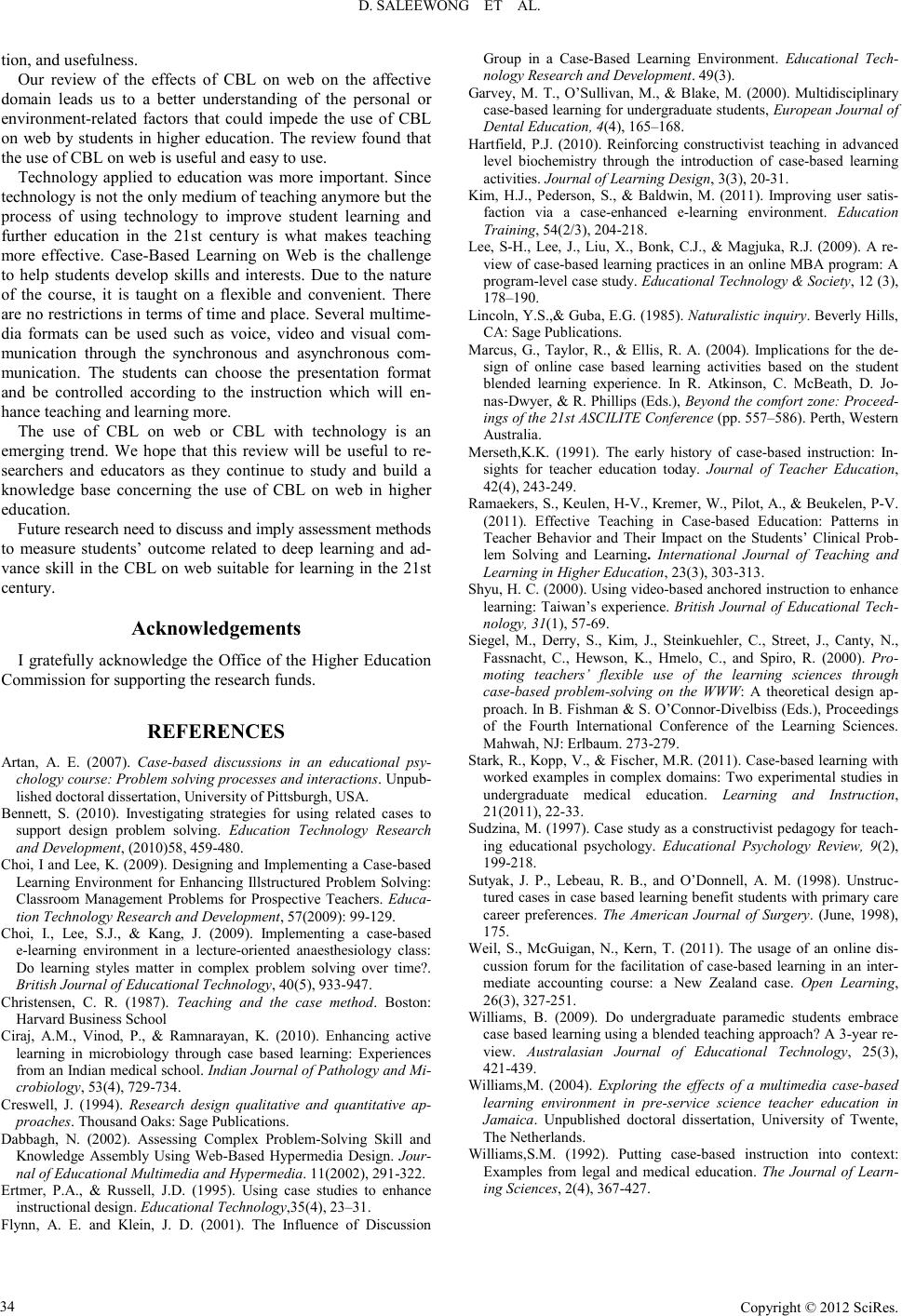Paper Menu >>
Journal Menu >>
 Creat ive Educati on 2012. Vol.3, Supplement, 31-34 Published Online December 2012 in SciRes (http://www.SciRP.org/journal/ce) DOI:10.4236/ce.2012 .38b007 Copyright © 2012 SciRes. 31 Case-Ba sed Learning on Web in Higher Education: A Review of Empirical Research Danucha Saleewong1, Praweenya Suwannatthachote1, Supa ttra Kuhakran2 1Faculty of Education, Chulalongk or n University, Bangkok, Thailand 2Office of E ducati on Technology, Sukh othai Thammathirat Open University, Bangkok, Thailand Email: dan uc ha _s@hotma il .co m , prawee ny a@g mail .com Received 20 1 2 Case-ba sed lear ning (CB L) on web makes i ts chall enging st udent s int erest ed and enga ged in l ear ning and to develop the skills. Because of the nature of teaching and learning on the web is teaching with the flexi bili ty and co mfort without res tri ctions of ti me and s pace w ith t he use of mult imedia for mats, suc h as text, audio, video and communication synchronization and asynchronization, students can choose for a pres ent ati on. Thi s review s u mmar i zes r es ult s of t his exi s ting r esea r c h on CBL on web i n higher educ at i on. Limitations of existing empirical studies are discussed and some directions for future research related to the use of C BL on web in higher educati on are suggested. Key words: Ca s e-Based Learning; CBL; Web; E-l earning; Di gital Learning; Onl ine Learning; High er Educa tion Introduction When new instructional innovations are introduced to students, they are implicitly or explicitly requested to adjust themselves to the new ways of teaching and learning by their instructors, who believe that new innovations may result in better learning outcomes than the previous approaches (Choi et al., 2009). Case based learning instruction is one of the constructivist oriented teaching approach (Sudzina, 1997) since it promotes students’ active participation so they could form their own learn- ing. Cases are stories with a message which students analyze and consider the solutions of these stories. The teacher and the students are working together while students have controlled analyzin g cases. There are many resear ch stu dies th at relat ed to the cases, used in teaching on the web, allow the students to study better (Dabbagh, 2002). In addition, case-based learning helps transfer knowledge and expectations of the students from their learning. The high level knowledge transfer will be more effective with case-based learning and problem solving on the web (Sutyak et al., 1998 and Siegel et al., 2000). This is consistent with the findings of Choi and Lee (2009) who studied the design and development of a case study to enha nce learning and problem- solving abilities of students and the study found that the CBL- CMPS enhance students’ problem solving. It also can be used in real life as well. Such claims and suggestions, however, have often not been based on empirical studies. This paper reviews the empirical research on Case-based learning on web in higher education to addres s th e quest ion “Wh at d oes th e empirical rese arch i nd icat e about CBL on web” Following a brief description of CBL on web, and common features, we describe our data sources, method of analyses and result findings. In the discussion we focus on directi ons for future research related to the use of CBL on web in higher education. Background Case-Based Learning on Web Case-Based Learning is often defined as a teaching method which requires students to actively participate in real or hypo- thetical problem situations, reflecting the kinds of experiences naturally encountered in the discipline under study (Ertmer & Russell, 1995). Case-based learning bridges the gap between theory and practice (Christensen, 1987; Ertmer & Russell, 1995; Flynn & Klein, 2001; Shyu, 2000; Williams, 1992). This in- structional method is suited for teaching the essential skills of analysis, decision making, critical thinking and problem solving in their professions (Merseth, 1991). Case-based learning has been extensively used in several areas of professional education such as law, medicine, clinical health, and business as an alternative to the traditional lecture as an instructional method (Artan, 2007; Garvey, O’Sullivan & Blake, 2000; Marcus, Taylor, & Ellis, 2004; Williams, 2004). The key to case-based learning is to create cases for educa- tional purposes and to facilitate activities associated with cases. Cases are like stories for reading and exploring interactively. Cases direct students toward contexts to discuss and debate issues dynamically. Williams (2004) summarizes the benefits of case used for tea ching an d learn ing, st ating th at it al lows learners to apply theoretical knowledge to real school contexts, reason critically about complex situations and recommend courses of actions, develop self-knowledge and recognize own assu mp - tion s, clarify person al beliefs abo ut teachi ng, compare and eva- luate their own and others’ perspectives, and develop the prac- tice of refl ection. While case-based learning challenges students by providing authentic experiences of situations (Williams, 2004), case studies itself will not guarantee the efficacy of online learning proc- esses since some ef fe ctive pedagogical approaches t hat instruct- tors use in their traditional classes may not be applicable for online environments. When case-based learn ing is implemented online, instructors should be aware that pedagogical activities can be either limited or fostered by conditions associated with technology tools employed. Technology can offer cognitive  D. SALEE WON G ET AL. Copyright © 2012 SciRes. 32 support for students’ thinking by reducing working memory limitations, and help them to represent evolving ideas, concepts, and solutions. At the same time, technology can burden stu- dents since they have to manage tasks and tool functions si- multaneously in the learning processes. (Lee, 2009) Method Sources of Data The search for peer-reviewed empirically based articles was condu cted in fou r stages. In t he first stage, se arches wer e made in electronic databases using descriptors including case-based learnin g, CBL. In the second stage, furth er searches on some of the articles not related with web, e-learning, digital learning, and online learning or technology were carried out. In the third stage, did further searches on some of the articles not related with higher education. And in the last stage, selected the articles published from 2009/01/01-2011/12/31. The electronic datab ases used for the literature search included Springer, ER I C, and Academic search Premier. The searches yielded a total of 221 articles. Out of these, 11 were iden tified for review and 8 of those 11 papers were based on various forms of self-report data (e.g. surve ys, in terview) or observations, and discussion forum transcripts. The question- naire survey was the most commonly used as data collection tool. Three papers were based on an experimen tal design. Method The current review follows the guidelines set by Creswell (1994), which stated that the goal of a review is to summarize the accumulated state of knowledge concerning the topic of interest and to highlight important issues that research has left unresolved. This is accomplished by summarizing the pre- do- minant research areas or topics, discussing the weaknesses or limitations of current research, and highlighting several direc- tions for future research related to the use of case-based learn- ing in education. The basic unit of analysis was each individual empirical article. Using the constant-comparative method espoused by Lincoln and Guba (1985), the coding scheme was not predetermined prior to our analysis but emerged inductively from the data. Specifically, the constant-comparative method involves the following steps: examining each individual article, forming various categories, comparing categories, and achieving cate- gory saturation. For example, we began by selecting the first article, reading it, and noting its content to form a tentative research topic catego ry. Findings The categories identified seemed to cluster into two groups: Case-based learning (CBL), we using profile and effects of Case-based learning (CBL) on web. Within each of these, there were two categories, as shown in Table 1. Case-Based Learning on Web Usage Profile Disciplines of study in which CBL on web were used. On the whole, past research on CBL on web had been carried out in four different disciplines: business (e.g., commerce and man- agement), science (e.g., biochemistr y), medical (e.g., doctoral), and edu cation (e.g., teacher educatio n). Overall, o ur analysis of previous research suggested that CBL on web had been most frequently used in the medical discipline (45%). This was fol- lowed by education (28%), business (18%), and science (9%). How students or instructors use CBL on web. The review found that Case-based learning on web has been applied to a variety of teaching and learn ing. It add resses the issues of inte- gration of diversified technological tools for pedagogical facili- tatio n of case-b ased acti vities an d develop ing multimedia cas es in order to enhance student involvement and engagement in understanding contexts embedded in cases toward solutions from mult ifaceted aspects, as sho wn in Table 2. Tabl e 1. List of major CBL on web topics. Topic Subtopics Case-based learnin g usage profile Disciplines of study in which case-b ased learning were used How students or instruc tors use case-based learning Effe cts of Case-bas ed learning Effe cts of Case-based learning on pe rfor manc e outcome Effe cts of Case-based learning on affective outcome Table 2. The review context of CBL on web. Study Context of CBL on web Weil et al. (2011) The case -based learning was introduced into Acct 210 in a n a synchr o nous di scuss io n m o de using the Moodle open source le arning software platform. Students used of case-ba sed learnin g for online discussion forum Hartfield (2010) The constructivis t teaching str ategy aime d to integrate the teaching and learning activities to the assessment items, and a set of case -based learning (CBL) function as the central teaching and learning acti vity that facilit ates alignment. Case-based learning used primary biochemistry res ea rch art icle s a s t he source of the problems and i nte g rate (and further de v e l op) t he students’ learning with the conc eptual theor y material covered within the fra mework of the lectur es. Students are support ed in their acquisition of competencies and skills in reading, assimilation and interpretati on of primary rese arch articles, as well as team working and c ommunication ski lls. Bennett (2010) Investigated lea rners’ underst anding of multimedia instruc tional and deve lopment derived from the analysis of two richly detailed cases, and how this understanding then supported learners in their own design projects. Student work from case an alysis, group project and reflective tasks was the key data source, complemented by interviews with students and their instructor, observations of class meetings, and the collection of on line discussi on list records and electronic res ource files.  D. SALEE WON G ET AL. Copyright © 2012 SciRes. 33 Study Context of CBL on web Kim et al. (2011) Stud e n t u sed onl i ne case-based le arning (CBL) module in the e-learning en vironment . Williams (2009) The case -b ased l earning in onl ine env ir onme nt used in the clinical cu rriculum of the Bachelor of Emergency Health (BEH) de gree. Cases were presente d in “web pa g e ” form at to eac h e-tutorial group in Blackboard. Students were given between 8-10 cases and additional learning reso urc es per se m e ster. Stud e n t s had onl i ne a cc ess to cases an d discussions for revision purposes. Choi and Lee (2009) Students used the online CBL-CMPS environment. The students were asked to complete Stages 1, 2, and 3 of the CBL-CMPS online and to submit their responses to the questions (proble m identific ation and solution generation) posed at the end of each stage as a homework assignment and the y checked out Stages 4 and /or 5 (one c ase did no t ha v e Stag e 5) for another homework assignment in the same way that they did for the previous stages. Choi et al. (2009) Students used case-based e-learning environment in anes thesiology cou rse. Effects of Case-Ba se d Le arning on Web Effect o f case-based learning on web on performance outco me, researchers were also interested in examine whether CBL on web could enhance thinking skill or participants’ learning, as shown in Table 3. Effect of case-based learning on web on affective outcome, researchers were also interested in affective outcome such as attitudes and satisfaction of using CBL on web. Most students agreed that the CBL on web was easy to use and had exciting experience to explore technologies and that CBL on web was fun and interesting, as shown in Table 4. Conclusion Our review found several limitations concerning previous empirical studies on CBL on web in higher education. We found that previous research studies related to CBL on web usage were limited mainly to discussion or technology-related disciplines such as medical, education and business. The dura- tion o f the research on CBL on web usage is an other limitatio n iden tified. Mo st research stu dies were lar gely cond ucted over a period of one semester. In some study that used experimental design, to compare between the use case-based learning and case-based learning with technology. For example, the study of Choi and Lee (2009), these results indicated that two of the seven sub-skills gained during the CBL-CMPS experience were transferred to a new case problem while three of the other sub-skills showed posi- tive potential for the transfer effects to some degree. To illu- strate ho w students’ answers wer e improved from th e pretest to the posttest. The results showed that the CBL-CMPS and its stages facilitated the college students in a) considering multiple perspectives, b) critically reviewing situations and solutions in Table 3. Review of CBL on web performa nce outcom e. Study Performance outcome Choi and Lee (2009) The individual comp onents of the CBL-CMPS promoted ill-structured p roblem solving abi lities respecti vely, and that the CBL-CMPS as a whole learn ing environmen t was effective to a degree for the transfer of learning in ill-structured problem solving. The potential, challenge, and implications of the CBL-CMPS are discussed Cirai et al. (2010) Students respond ed that, apart from helping them a cquire substantive knowledge in microbiology, CBL sessions enhanced their analytic, collaborative, and c ommunication skills. Hartfi eld (2010) Students perceive that this approach enables the development of problem-solving skills and confir ms that students identify a high degree of alignment between teaching and learning activities and assessment. And a case-based learning paradigm can faci litate constructive alignment of teaching and learning activities with assessment, and tha t this approach supports and bolst er s students’ satisfac tion and leads to improved academic performance of students. Weil et al. (2011) Students percei ve numerous benefits associated with case-based onlin e discussions , including being exposed to othe r st u dents’ opinions, im pr o v ing the ir abili ty to critically review cas e information, motiva t ion to co n sult additional non-co urse rel ate d ma te rial and the convenience of the technology utiliz ed. Lee et al. (2009) It addr esse s th e is sues of integration of diversified technological t ools for pedagogical facilita tion of case-based acti vities and developing multim edia ca ses in order to enhance students’ involvement and engagement in understanding contexts embedded in cases toward solutions from multifaceted aspects. Bennett (2010) The result that the case analysis task r aised learners’ awareness of design approaches and project management strategies, and that discussion and reflection play critical roles in developing students’ understanding. The study also highlighted some lim itations of th e case approach, suggesti ng th e ne ed for strate g ies that suppor t learne rs’ thinking and reasoning. Table 4. Review of CBL on web affective outcome. Study Affective outcome Kim et al. (2011) CBL module showed higher average scores than the comparis on group across a ll scores : Easy to u se Easy to learn Usefulness and Satisfaction. Hartfield (2010) Case-based learning paradigm supports and bolsters student satisfaction and leads to improved student academic performance. social and historical contexts , c) developing coherent arguments, and d) applying theories to their arguments to a certain degree while solving ill-structured problems. In the stud y of Ki m et al. (2011) the experimental design by treatment groups using tu- torial with case-based learning (CBL) module and comparison groups using tutorial only. The results found that a significant increase in the level of domain knowledge in both a tutorial- only group and a tutorial with CBL module group. The tutorial with CBL group scored significantly higher on learners’ per- ceptions of the e-learnin g envir onmen t in ter ms of us e, sati s fac-  D. SALEE WON G ET AL. Copyright © 2012 SciRes. 34 tion, and usefulness. Our review of the effects of CBL on web on the affective domain leads us to a better understanding of the personal or environment-related factors that could impede the use of CBL on web by students in higher education. The review found that the use of CBL on web is useful and easy to use. Technology applied to education was more important. Since technology is not the only medium of teaching anymore but the process of using technology to improve student learning and further education in the 21st century is what makes teaching more effective. Case-Based Learning on Web is the challenge to help students develop skills and interests. Due to the nature of the course, it is taught on a flexible and convenient. There are no r estrictions i n terms of time an d place. Several multime- dia formats can be used such as voice, video and visual com- munication through the synchronous and asynchronous com- munication. The students can choose the presentation format and be controlled according to the instruction which will en- hance t eaching and lear ning more. The use of CBL on web or CBL with technology is an emerging trend. We hope that this review will be useful to re- searchers and educators as they continue to study and build a knowledge base concerning the use of CBL on web in higher educat i o n. Futu re rese ar ch need to di scus s and impl y a ss ess ment met hods to measure students’ outcome related to deep learning and ad- vance skill in the CBL on web suitable for learning in the 21st centu ry. Acknowledgements I gratefully acknowledge the Office of the Higher Education Commission for supporting the research funds. REFERENCES Artan, A. E. (2007). Case -based discussions in an educational psy- chology course: Problem solving processes and interactions. Unpub- lished doctoral dissertation, University of Pittsburgh, USA. Bennett, S. (2010). Investigating strategies for using related cases to support design problem solving. Education Technology Research and Development, (2010)58, 459-480. Choi, I and Lee, K. (2009). Designing and Implementing a Case-based Learning Environment for Enhancing Illstructured Problem Solving: Classroom Management Problems for Prospective Teachers. Educa- tion Technology Research and Development, 57(2009): 99-129. Choi, I., Lee, S.J., & Kang, J. (2009). Implementing a case-based e-learning environment in a lecture-oriented anaesthesiology class: Do learning styles matter in complex problem solving over time?. British Journal of Educationa l Technology , 40(5), 933-947 . Christensen, C. R. (1987). Teaching and the case method. Boston: Harvard Business School Ciraj, A.M., Vinod, P., & Ramnarayan, K. (2010). Enhancing active learning in microbiology through case based learning: Experiences from an Indian medical school. Indian Journal of Pathology and Mi- crobiology, 53( 4) , 72 9-734. Creswell, J. (1994). Research design qualitative and quantitative ap- proa ches. Thousand Oaks: Sage Pub lications. Dabbagh, N. (2002). Assessing Complex Problem-Solving Skill and Knowledge Assembly Using Web-Based Hypermedia Design. Jour- nal of Educational Multimedia and Hypermedia. 11(2002), 291-322. Ertmer, P.A., & Russell, J.D. (1995). Using case studies to enhance instr u ctional de s ig n. Educational T ech nology,35(4), 23–31. Flynn, A. E. and Klein, J. D. (2001). The Influence of Discussion Group in a Case-Based Learning Environment. Educational Tech- nology Research and Development. 49(3). Garvey, M. T., O’Sullivan, M., & Blake, M. (2000). Multidisciplinary case-based learnin g for undergraduate stud ents, European Jou rnal of Dent a l Educati o n , 4(4), 16 5–168. Hartfield, P.J. (2010). Reinforcing constructivist teaching in advanced level biochemistry through the introduction of case-based learning activities. Journal of Learning Desig n, 3(3), 2 0-31. Kim, H.J., Pederson, S., & Baldwin, M. (2011). Improving user satis- faction via a case-enhanced e-learning environment. Education Training, 54(2/3), 204-218. Lee, S-H., Lee, J., Liu, X., Bonk, C.J., & Magjuka, R.J. (2009). A re- view of case-based learning practices in an online MBA program: A program -level case study. Educati onal Techno logy & Society, 12 (3), 178–190. Lincoln, Y.S.,& Guba, E.G. (1985). Naturalistic inquiry. B everl y Hi lls , CA: Sage Publications. Marcus, G., Taylor, R., & Ellis, R. A. (2004). Implications for the de- sign of online case based learning activities based on the student blended learning experience. In R. Atkinson, C. McBeath, D. Jo- nas-Dwyer, & R. Phillips (Eds.), Beyond the comfort zon e: P roceed- ings of the 21st ASCILITE Conference (pp. 55 7–586). Perth, Western Australia. Merseth,K.K. (1991). The early history of case-based instruction: In- sights for teacher education today. Journal of Teacher Education, 42(4), 243-249. Ramaekers, S., Keulen, H-V., Kremer, W., Pilot, A., & Beukelen, P-V. (2011). Effective Teaching in Case-based Education: Patterns in Teacher Behavior and Their Impact on the Students’ Clinical Prob- lem Solving and Learning. Int ernational Journal of Teaching and Learning in Higher Education, 23(3), 303-313. Shyu, H. C. (2000). Using video-based anchored instruction to enhance learning: Taiwan ’s experien ce. British J ournal of Edu cational Tech- nology, 31(1), 57-69. Siegel, M., Derry, S., Kim, J., Steinkuehler, C., Street, J., Canty, N., Fassnacht, C., Hewson, K., Hmelo, C., and Spiro, R. (2000). Pro- moting teachers’ flexible use of the learning sciences through ca se -based problem-solving on the WWW: A theoretical design ap- proach. In B. Fishman & S. O’Connor-Divelbis s (Eds.), Proc eedings of the Fourth International Conference of the Learning Sciences. Mahwah, NJ: Erlbaum. 273-279. Stark, R., Kopp, V., & Fischer, M.R. (2011). Case-based learn ing with worked examples in complex domains: Two experimental studies in undergraduate medical education. Learning and Instruction, 21(2011), 2 2-33. Sudzina, M. (1997). Case study as a constructivist pedagogy for teach- ing educational psychology. Educ ational Psychology Review, 9(2), 199-218. Sutyak, J. P., Lebeau, R. B., and O’Donnell, A. M. (1998). Unstruc- tured cases in case based learning benefit students with primary care career preferences. The American Journal of Surgery. (June, 1998), 175. Weil, S., McGuigan, N., Kern, T. (2011). The usage of an online dis- cussion forum for the facilitation of case-based learning in an inter- mediate accounting course: a New Zealand case. Open Learning, 26(3), 327-251. Williams, B. (2009). Do undergraduate paramedic students embrace case based learning using a blended teaching approach? A 3-year re- view. Australasian Journal of Educational Technology, 25(3), 421-439. Williams,M. (2004). Exploring the effects of a multimedia case-based learning environment in pre-service science teacher education in Jamaica. Unpublished doctoral dissertation, University of Twente, The Netherlands. Williams,S.M. (1992). Putting case-based instruction into context: Examples from legal and medical education. The Journal of Learn- ing Sciences, 2(4), 36 7-427. |

